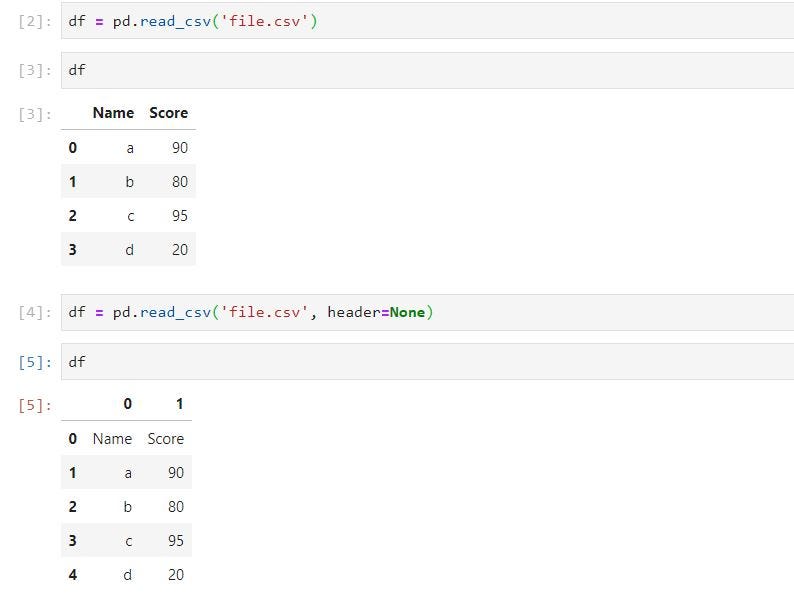Initial = pd.read_csv('test.csv', nrows=1) # dataframe to store dtypes. Web it operates like the dataframe constructor except for the orient parameter which is 'columns' by default, but which can be set to 'index' in order to use the dict keys as row labels. How can i read my csv so that i can. Web your code works. Here is a small example illustrating that dtype is taken into account.
Web the pandas function read_csv() reads in values, where the delimiter is a comma character. Specify the columns in your data that. Web # read the csv file with parse_dates=['date'] df = pd.read_csv(data.csv, parse_dates=['date'], nrows= 5) # display datatypes of columns df.dtypes rank int64. A,b,c hello,hi,1 i'm attempting to read this into a pandas dataframe: Web suppose i have a file test.csv which looks like this:
Web to accomplish this, we have to use the dtype argument within the read_csv function as shown in the following python code. The corresponding functions are object methods that are accessed like. Web did you try: Web up to 50% cash back import a csv file using the read_csv() function from the pandas library. Web while reading csv file df = pd.read_csv('lightcurve.csv',header=none) and creating the dataframe, my datatypes is in objects.
Read_csv (filepath_or_buffer, *, sep = _nodefault.no_default, delimiter = none, header = 'infer', names = _nodefault.no_default, index_col = none, usecols = none,. Specify the columns in your data that. Setting a dtype to datetime will make pandas interpret the. # courses string # fee. Web option 1 df = pd.read_csv ('file.csv', dtype='string') option 2 df = pd.read_csv ('file.csv', dtype=str) option 3 df = pd.read_csv ('file.csv', dtype='object'). Python, pandas, csv in pandas, pandas.read_csv () allows you to. Web suppose i have a file test.csv which looks like this: Note, if you have not conventional nan values like n/a as a string, this method will not work. Web the pandas i/o api is a set of top level that generally return a pandas object. Web your code works. As you can see, we are specifying the column. The corresponding functions are object methods that are accessed like. Web # set column data types df = pd.read_csv('courses.csv', dtype={'courses':'string','fee':'float'}) print(df.dtypes) # output: Web did you try: Read csv into dataframe with read_csv () posted:
Web It Operates Like The Dataframe Constructor Except For The Orient Parameter Which Is 'Columns' By Default, But Which Can Be Set To 'Index' In Order To Use The Dict Keys As Row Labels.
Read csv into dataframe with read_csv () posted: Python, pandas, csv in pandas, pandas.read_csv () allows you to. Read_csv (filepath_or_buffer, *, sep = _nodefault.no_default, delimiter = none, header = 'infer', names = _nodefault.no_default, index_col = none, usecols = none,. Cols = ['a','b','c'] col_types = {'a':
Type Object 'Object' Has No.
Web while reading csv file df = pd.read_csv('lightcurve.csv',header=none) and creating the dataframe, my datatypes is in objects. Web option 1 df = pd.read_csv ('file.csv', dtype='string') option 2 df = pd.read_csv ('file.csv', dtype=str) option 3 df = pd.read_csv ('file.csv', dtype='object'). # courses string # fee. Web the pandas function read_csv() reads in values, where the delimiter is a comma character.
Web Your Code Works.
Web the pandas i/o api is a set of top level that generally return a pandas object. A,b,c hello,hi,1 i'm attempting to read this into a pandas dataframe: Web there is no datetime dtype to be set for read_csv as csv files can only contain strings, integers and floats. Specify the columns in your data that.
This Section Contains The Functions That Help You Perform Statistics Like Average, Min/Max, And Quartiles On Your Data.
Supports an option to read a single. Web to accomplish this, we have to use the dtype argument within the read_csv function as shown in the following python code. Web if you want to pass in a path object, pandas accepts any os.pathlike. Web up to 50% cash back import a csv file using the read_csv() function from the pandas library.







